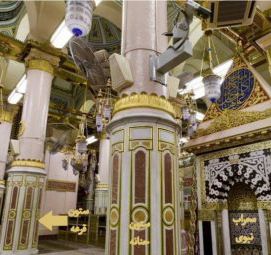Al-Qurʿa Pillar
Al-Qurʿa Pillar (Arabic: القُرعَه) is one of the pillars of Masjid al-Nabi, which according to a narration, if Muslims know the value of this place, they will draw lots to pray there. Since the narrator of this hadith was Aisha, this Pillar was called by the name of Aisha and it is still known by the same name, and the phrase Aisha’s pillar is written on top of it. Also, because of the gathering of Meccan immigrants around this pillar, it is also called the pillar of immigrants. According to a narration, supplication next to this pillar is fulfilled. It is also mentioned that the Companions used to pray next to this pillar.
 | |
| General Information | |
|---|---|
| Other Names | Aisha’s Pillar, pillar of immigrants |
| Place | Medina, Masjid al-Nabi, in Rawza al-Nabi |
| Religious Aspect | |
| Religious Affiliation | Muslims |
| Rituals | praying next to this pillar |
location of Al-Qurʿa Pillar
This pillar is one of the pillars of Rawza al-Nabi, which is the third pillar from the side of the prophet’s pulpit and the grave of the prophet[1] and is located next to the current mihrab. In other words, this pillar is located in the middle of the main pillars and there are two pillars between it and the prophet’s pulpit, and two pillars between it and the grave of the prophet, and two pillars between the Qibla and the current mihrab, and it is considered the third pillar on each side. It is located next to the pillar of Al-Tawba and Al-Sarīr.[2]
Al-Qurʿa Pillar, a place to overtake in prayer
The reason for this name is that Aisha narrated from the Prophet: In my mosque, near this pillar, there is a place where if people know the reward and virtue of praying there, they will draw lots to pray there.[3]
Aisha’s Pillar
It is known that because Aisha reported a narration from the Prophet about the virtue of praying next to it, it was called by this name.[4] Perhaps it is because Aisha informed about it and determined its place.[5] Some believe that this name was taken after Aisha.[6]Now above it, the word “This is the pillar of Aisha” is written.[7]
pillar of immigrants
This pillar is also known as “Immigrant pillar”; Because the Meccan immigrants used to sit next to it to talk. Hence, it was also called “Majlis of muhājirān”.[8]
pillar of Mukhalliqa
Some have mentioned it as “Mukhalliqa pillar”; Because this pillar is also perfumed with aromatic substances like the Mukhalliqa pillar.[9]
Virtue of Al-Qurʿa Pillar
According to narrations, supplication is fulfilled near this pillar.[10] It is said that some companions prayed near it.[11] Some caliphs, as well as Ibn Zubayr and his son ʿāmir, also prayed next to it.[12]
Notes
- ↑ Ibn Zabāla, Akhbār al-madīna, p. 101; Maṭarī, Al-Taʿrīf bimā ʾansat al-hijra, p. 91; Najjār, Al-Durra al-thamīna, p. 296.
- ↑ Qāʾidān, Tārīkh wa āthār-i Islāmi Makka wa Madīna, p. 191.
- ↑ Samhūdī, Wafāʾ al-wafā, vol. 2, p. 176; Yamānī, Mawsūʿa makka al-mukarrama, vol. 2, p. 443.
- ↑ Haythamī, Majmaʿ al-zawāʾid, vol. 4, p. 9; Ṭabarānī, Al-Muʿjam al-awsaṭ, vol. 1, p. 264.
- ↑ Ibn Zabāla, Akhbār al-madīna, p. 101; Maṭarī, Al-Taʿrīf bimā ʾansat al-hijra, p. 91; Najjār, Al-Durra al-thamīna, p. 296.
- ↑ Yamānī, Mawsūʿa makka al-mukarrama, vol. 2, p. 443.
- ↑ Yamānī, Mawsūʿa makka al-mukarrama, vol. 2, p. 443.
- ↑ Samhūdī, Wafāʾ al-wafā, vol. 2, p. 176; Yamānī, Mawsūʿa makka al-mukarrama, vol. 2, p. 443.
- ↑ Ibn Zabāla, Akhbār al-madīna, p. 100; Shurrāb, Al-Ma ʿālim al-athīra, p. 44; Samhūdī, Wafāʾ al-wafā, vol. 2, p. 177.
- ↑ Maṭarī, Al-Taʿrīf bimā ʾansat al-hijra, p. 91; Najjār, Al-Durra al-thamīna, p. 296.
- ↑ Amīnī, Al-Ghadīr, vol. 5, p. 124; Subḥānī, Al-Zīyāra fī al-kitā wa al-sunna, p. 40.
- ↑ Ibn Zabāla, Akhbār al-madīna, p. 101; Samhūdī, Wafāʾ al-wafā, vol. 2, p. 176.
References
- Amīnī, ʿAbd al-Ḥusayn. Al-Ghadīr fī al-kitāb wa al-sunna wa al-ʾadab. Tehran: Dār al-Kutub al-Islāmiyya, 1372 Sh.
- Haythamī, ʿAlī b. Abūbakr. Majmaʿ al-zawāʾid wa manbaʿ al-fawāʾid. Beirut: 1402 AH.
- Ibn Zabāla. Akhbār al-madīna. Medina: Markaz Buḥūth wa Darāsāt al-Madina al-Munawwara, 1424 AH.
- Maṭarī, Muḥammad b. Aḥmad al-. Al-Taʿrīf bimā ʾansat al-hijra min maʿālim dār al-hijra. Riyadh: Dār al-malik ʿAbdu-l ʿAzīz, 2005.
- Najjār, Muḥammad b. Maḥmūd al- .Al-Durra al-thamīna fī akhbār al-madina. Medina: Markaz Buḥūth wa Darāsāt al-Madina al-Munawwara, 1427 AH.
- Qāʾidān, Aṣghar. Tārīkh wa āthār-i Islāmi Makka wa Madīna. 4th edition. Qom: Nashr-i Mashʿar, 1381 Sh
- Samhūdī, ʿAlī b. ʿAbd Allāh. Wafāʾ al-wafā bi akhbār dar al-Muṣṭafā. Edited by Muḥammad Muḥyi al-Dīn ʿAbd al-Ḥamīd. Beirut: 1984.
- Shurrāb, Muḥammad b. Muḥammad Ḥasan. Al-Maʿālim al-athīra. Tehran: Mashʿar, 1383 sh.
- Subḥānī, Jaʿfar. Al-Zīyāra fī al-kitā wa al-sunna. Qom: Muʾassisat Imām al-Ṣādiq, 1439 AH.
- Ṭabarānī, Sulaymān b. Aḥmad. Al-Muʿjam al-awsaṭ. Edited by Abū Maʿādh Ṭāriq b. ʿIwad Allāh. Cairo: 1415-1416 AH.
- Yamānī, Aḥmad Zakkī. Mawsūʿa makka al-mukarrama wa al-madina al-munawwara. London: Muʾssisa al-furqān, 1429 AH.